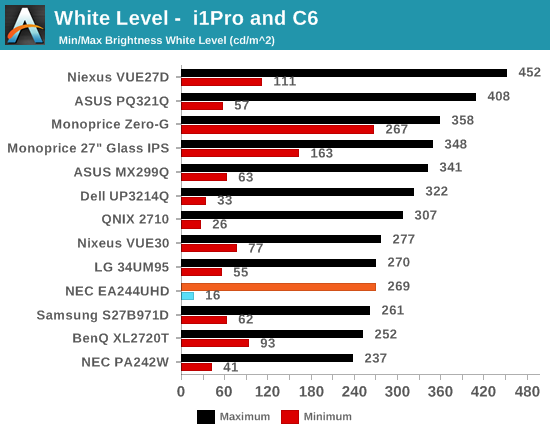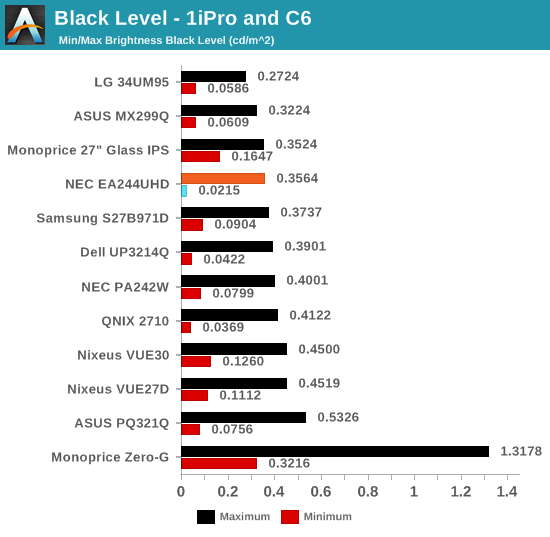NEC EA244UHD Review
by Chris Heinonen on August 7, 2014 2:30 PM ESTBrightness and Contrast
For all of the measurements I enabled the display uniformity option. This can reduce brightness and contrast ratio, but it also produces a more uniform image which I believe is worth the tradeoff. Given the target for the EA244UHD I feel most people would also leave this enabled.
The maximum light output with this enabled is only 269 cd/m2. Setting the backlight to minimum drops this all the way down to 16 cd/m2. This is a very wide range but it's not incredibly bright. Most people using the EA244UHD probably have some sort of light control but if you don’t, bright sunlight will wash it out pretty well.

With an IPS panel and uniformity compensation, black levels are what I expect to see from an NEC display. They are okay but not excellent. NEC could improve these by using a VA-panel, but that leads to sacrifices in off-angle viewing. Instead of uniformity compensation, NEC could use some sort of dimming system to improve blacks, but those almost always harm image quality.

Due to those so-so black levels we get a contrast ratio right around 750:1. IPS panels can do 1,000:1 or almost 1,200:1 now, but not with the uniformity compensation feature. When we look at display uniformity later we can see if this is worth the tradeoff that NEC has made.

This section could have been copied almost verbatim from any other NEC monitor review I have done. The EA244UHD isn’t as bright or punchy as other IPS displays, but it might offer better uniformity because of it. This is the compromise NEC has always made before, and in the past it has proven to be worthwhile.










57 Comments
View All Comments
DanNeely - Friday, August 8, 2014 - link
The former as in "I couldn't type yesterday"piroroadkill - Friday, August 8, 2014 - link
Total disagree. I'd rather have a 40" 3840×2160 monitor and run it at 100%.I don't want increased DPI, I wanted increased size and res :D
AnnonymousCoward - Saturday, August 9, 2014 - link
piroroadkill, yup, same here. 44" gives 100 PPI. Someone just needs to make one, and curve it while they're at it (and stop curving the damn TVs).althaz - Friday, August 8, 2014 - link
Agreed. What I want is a 30" 4k monitor (ideally 16:10) that can handle 4k @ 60Hz. Everything else just needs to be "good enough". Ideally I'd prefer a VA monitor for the better contrast (FAR prefer good contrast over slightly better off-angle viewing), or better yet an OLED (probably still years away), but 30" 4k with good enough everything else at the right price would get me over the line for a pair of them right now.piroroadkill - Friday, August 8, 2014 - link
An 8:5 (1.6:1) AR monitor of this resolution? Not a chance. You'd have to go back to 2001.https://en.wikipedia.org/wiki/IBM_T220/T221_LCD_mo...
Shadowself - Friday, August 8, 2014 - link
Probably true, 16:10 seems to be, unfortunately, a thing of the past. However, an ~ 30" 4096x2560 monitor would be truly wonderful!Tristor - Friday, August 8, 2014 - link
I completely disagree. The benefit of 4K to me is the much increased PPI which makes it possible to utilize actual high resolution textures without the need for anti-aliasing in CGI work and having a denser amount of screen real estate for code work. I already run 3x1080P 23" displays, so 24" is about my max size for displays, and being able to quadruple my resolution (and PPI) in the same footprint is amazing and just what I'm looking for.My only holdout is waiting to see the dust settle on all the 24" IPS UHD options so I can pick what will end up being a good choice for the long-term, then I'll be ordering 3 of them. NEC is one company I've definitely been watching, as has Dell. I'm looking forward to seeing what Eizo actually releases. They showed off a new 24" UHD Color Edge at NAB that looks fantastic, including being a native 10-bit UHD panel.
For gaming, maybe it'd be fine to just have one larger UHD monitor, but I could easily see myself using my same setup for gaming with the monitors just rotated into portrait mode with nVidia Surround to make the most of it. There's just no advantage I can see to a larger physically sized display unless you don't have proper vision correction.
MrSpadge - Monday, August 11, 2014 - link
Then simply don't buy it - there are larger models available, of course. The modles around 24" are for people who's desk is not large enough for 30"+.CSMR - Thursday, August 7, 2014 - link
No need for such a high resolution resolution. 2160p is extreme and goes beyond what is needed for sharpness, adding cost and gpu requirements.The usual 1200p of 24" monitors, or even 1080p, are too low, but 1440p or 1600p would have been perfect.
Why is the PC market quadrupling pixel counts so that we are left with either lowish dpis or extremely high dpis and nothing in the middle?
fokka - Thursday, August 7, 2014 - link
there have been 1600p/30" and 1440p/27" displays for ages now, i think an upgrade to 4k/uhd is nothing too crazy in 2014. 2160p on 24" is a bit much as we see, yes, but we have 1080p on our 5" phones, 1800p and above on 15" laptops, i think it's good that the market is moving again.where you are right though is that they should offer more 1200p-1600p displays in the 20-24" region, that would be very nice and reasonable indeed.